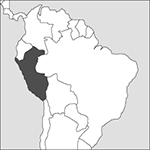
Source: MAPS IN MINUTES™ © RH Publications (1997)
Capital:
Lima
Area:
1,285,216 sq km (496,225 sq miles)
Population:
27,968,000 (2005)
Currency:
1 nuevo sol = 100 centimos
Religions:
Roman Catholic 86.2%; Protestant 5.2%
Ethnic Groups:
Quechua 47.0%; Mestizo 32.0%; European 12.0%; Aymara 5.0%
Languages:
Spanish, Quechua (both official); Aymara
International Organizations:
UN; OAS; Andean Community; Non-Aligned Movement; WTO
A country on the Pacific coast of South America, bounded by Ecuador and Colombia on the north, Brazil and Bolivia on the east, and Chile on the south.
Physical
The north-east of the country is in the upper Amazon basin and comprises equatorial rainforest. The south-west half is occupied by the Andes mountain ranges, whose snow-capped peaks rise to over 6500 m (21,000 feet). Between the ranges are plateau areas, the high mountain lake, Titicaca, in the extreme south-east, and many valleys used for cultivation and the rearing of livestock. Minerals are found in rich profusion. The coastal plain is arid and mostly desert, cooled by the Peru Current.
Economy
Exports include copper, gold, zinc, lead, and silver. There is a wide range of agriculture, and Peru is almost self-sufficient in food. Llamas and sheep provide wool for export. One of the world’s leading producers of fishmeal, Peru has a well-established manufacturing sector and exploits significant oil and natural gas reserves. There is widespread illegal cultivation of coca, processed in Colombia into cocaine.
History
Peru was the site of a succession of complex cultures and states from c.1000 bc: Chavín in the central Highlands, Mochica on the northern coast, Nazca on the southern coast, and Tiahuanaco round Lake Titicaca in the Andes. Between c.600 ad and 1000 Huari in the central Andes conquered a small ‘empire’, and the Chimú state rose on the northern coast c.1000. The Incas were another such group, based round Cuzco, who began their regional expansion c.1200 and eventually conquered a vast empire stretching from Chile to Ecuador during the 15th century. Spanish invader Francisco Pizarro’s defeat of Atahualpa in 1532 was followed by rivalry for control and led eventually to direct rule by the Spanish crown. Inca revolts continued for nearly 50 years. The vice-royalty, with its capital at Lima, attempted to placate the various factions but was not in reasonable control until the mid-16th century. Further Inca insurrections occurred in 1780, led by Tupac Amarú, and in 1814.
In 1821 José de San Martín captured Lima, proclaiming an independent republic and issuing a constitution (1823). In 1824 José de Sucre won the Battle of Ayacucho, and Spanish troops were withdrawn. Political quarrels in the new republic led to an invitation to Simón Bolívar to accept the powers of a dictator. He tried unsuccessfully to bring Peru into his state of Gran Colombia (which comprised present-day Colombia, Ecuador, and Venezuela). A long period of civil war followed, the situation stabilizing under President Ramón Castilla (1844–62), who ended slavery, established an education system, and promoted the extraction of guano (natural nitrates and phosphates produced from sea-bird droppings), which brought immediate prosperity but was soon exhausted. The loss of nitrate revenue and the cost of the War of the Pacific (1879–84) led to national bankruptcy in 1889. Civilian politics had emerged in the 1870s with two parties, the Democrats and the Civilians, alternating in office. The latter, led by Augusto Leguia, held power (1908–30), introducing progressive legislation and settling the Tacna–Arica Dispute. After World War I a radical group, the Alianza Popular Revolucionaria Americana (APRA), led by Haya de la Torre, sought to obtain greater participation in politics by the Indians. President Manuel Prado, elected in 1939, aligned Peru with US policies in World War II. Terry Belaúnde gained office in 1963. In 1968 a left-wing military junta seized power, seeking to nationalize US-controlled industries. A more moderate junta succeeded in 1975, and in 1979 elections were again held. In 1980 Belaúnde was re-elected President, when a new constitution was established. In the face of severe economic problems Belaúnde succeeded in re-democratizing the country, and in 1985 President Alan García was elected. Confronted by massive rescheduling requirements for Peru’s foreign debts, his regime imposed an austerity programme and engaged in a guerrilla war against a strong ultra-left Maoist group, Sendero Luminoso (‘Shining Path’). His APRA Party did badly in the 1990 elections, when the son of Japanese immigrants, Alberto Keinya Fujimori of the Cambio 90 Party, was elected President. The austerity measures which he continued resulted in protests, with strikes and guerrilla attacks across the country. In September 1992, however, his government captured and imprisoned Abimael Guzmán, who had founded and led Sendero Luminoso since 1970. Fujimori was re-elected in 1995 and again in 2000 but, amid allegations of corruption and electoral fraud, he resigned later in the year. Alejandro Toledo was elected President in 2001; he was succeeded by the former President Alan García, who was elected in 2006. He was succeeded in 2011 by former army officer Ollanta Humala Tasso of the Peruvian Nationalist Party. Former Prime Minister Pedro Pablo Kuczynski (known in Peru by his initials PPK) won the 2016 election, just defeating Keiko Fujimori (daughter of Alberto) in the run-off contest between these two conservatives. Fujimori’s party, Popular Strength, won an outright majority in Congress.
- denial of service
- denial of service attack
- Denikin, Anton Ivanovich (1872–1947)
- Denisovan
- denitrification
- Denmark
- Dennett, Daniel Clement (1942–)
- Denning, William Frederick (1848–1931)
- denominator
- denormalization
- denotation
- denotational semantics
- denote
- denoting phrase
- de novo pathway
- dense body
- dense gas
- dense matrix
- Dense-medium separation
- dense order
- dense set
- Dense Wavelength Division Multiplexing
- densitometer
- density
- density current